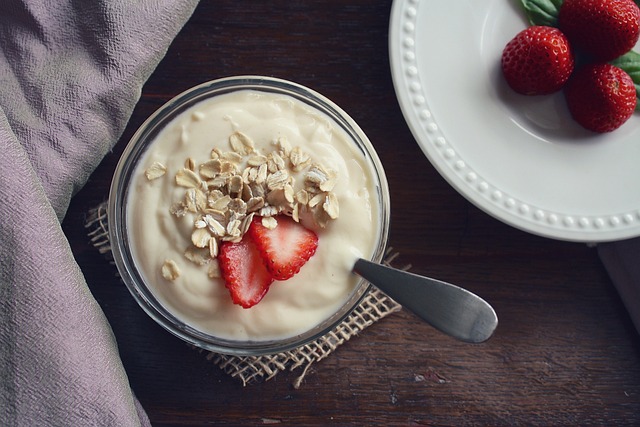
If you’re a yogurt lover, you’ve probably noticed the product selections expand significantly over the last decade. In some stores, the yogurt section can be as overwhelming as walking into a supplement store in search of the best multivitamin.
Whether you’re looking for whipped, yogurt with mix-ins, full-fat, low-fat, fat-free, or non-dairy, there’s something for everyone. Lactose-free yogurt has garnered more attention and we’re seeing more options. But what is it, who is it made for, and how do you choose the best lactose-free yogurt brands?
Lactose and Lactose Intolerance
Lactose is a type of sugar (carbohydrate) found naturally in animal milk and dairy products. Chemically, it’s a disaccharide, which means it’s made of two simple sugars: glucose and galactose. To properly digest lactose, it has to be broken down into these simple sugars by an enzyme called lactase. It can then be absorbed into your intestinal tract.
There are an estimated 4 billion adults with lactose intolerance around the world. One explanation for this is that humans begin losing the expression of the lactase enzyme after around 2 years of age.
This is likely because it’s around this age when most children are done weaning from their mother’s milk and no longer require lactase to digest and absorb it properly. Interestingly, not everyone develops the same degree of lactase deficiency as they grow up and some adults can digest lactose (and consume dairy products) just fine.
However, when the body produces insufficient lactase, lactose remains undigested in the gut, leading to symptoms of lactose intolerance such as bloating, gas, stomach cramps, and diarrhea. Lactose intolerance is common, particularly among adults, and varies widely among different populations and ethnic groups. The severity of the intolerance can also vary between people and not everyone with lactose intolerance has to completely avoid all dairy products.
What is Lactose-Free Yogurt?
Lactose-free yogurt is a dairy product specifically designed for people who are lactose intolerant. To make it, the lactase enzyme is added during production, which breaks down the lactose into simple sugars. The manufacturer might treat the milk with lactase before the fermentation process or simply use lactose-free milk in the process.
The result is a yogurt that retains all the nutritional benefits and taste of regular yogurt without the unwanted side effects of lactose intolerance. This makes it an excellent dietary option for those who need to avoid lactose but still want to enjoy the creamy texture and probiotic benefits of traditional yogurt.
Types of Lactose-Free Yogurt
Luckily, my lactose-free friends aren’t stuck with just one option when searching for a yogurt they can tolerate. You may be pleasantly surprised by how many there are, including:
- Plain: Made without added flavors or sweeteners, this option has a neutral taste ideal for cooking, baking, or as a base for smoothies, sauces, and dressings.
- Flavored: Available in flavors like vanilla, strawberry, blueberry, and peach, these are sweetened and often have fruit pieces or purees mixed in, making them a nice quick snack, dessert, or breakfast food.
- Greek-style: Greek-style yogurt is strained to remove much of the whey, resulting in a thicker, creamier texture with higher protein content. Use it in place of sour cream or as a high-protein snack.
- Probiotic-enriched: This yogurt has added live cultures and probiotics to offer extra gut health benefits. Look at the label to verify that it has live and active cultures.
- Drinks: There are lactose-free drinkable yogurts that come in various flavors and are designed for convenience, whether you want them for a quick breakfast, snack, or to add to smoothies.
- Non-dairy: These are naturally lactose-free because they’re not derived from cow’s milk. If you prefer to avoid all dairy products, look for plant-based yogurts made from soy, coconut, oats, almonds, or cashews.
Nutritional Profile
Just because yogurt doesn’t contain lactose doesn’t mean it suffers nutritionally. Here’s a look at the basic nutritional makeup of lactose-free yogurt:
- Calories: The calorie content depends on its fat content and whether it contains added sugars or flavors. Plain, fat-free, or certain non-dairy versions generally have fewer calories.
- Protein: Lactose-free yogurt is a good source of high-quality protein, which is essential for muscle repair, growth, and overall body function. Greek-style typically has higher protein content than regular.
- Calcium: Lactose-free yogurt provides calcium for strong bones and teeth, and supports muscle and nerve function. The calcium content in lactose-free yogurt is comparable to that in regular yogurt.
- Vitamins: Lactose-free yogurt is rich in several important vitamins, including B vitamins (like B12 and riboflavin) which are key for energy production and a healthy nervous system. Many types are fortified with vitamin D, supporting calcium absorption and healthy bones.
- Carbohydrates: Just because lactose-free yogurt contains lactose broken down into simple sugars doesn’t mean it’s carb-free. If you’re concerned about carb content, check the nutrition label as flavored versions may contain added sugars.
- Fat: Fat content can vary depending on whether it’s made from whole, low-fat, or fat-free milk. Fat is important for the absorption of fat-soluble vitamins A, D, E, and K.
Benefits of Lactose-Free Yogurt
The biggest benefit of eating lactose-free yogurt is that it’s designed to be tolerable among individuals who have lactose intolerance, without having to give up yogurt altogether.
Removing (or pre-digesting) the lactose in yogurt doesn’t significantly alter the nutritional makeup. Lactose-free yogurt still has essential nutrients like calcium, vitamins B12 and D, protein, and fat. It often contains probiotics that support gut health and support your immune system.
Finally, like other yogurt, it’s a convenient snack or breakfast option that can be easily grabbed for an afternoon snack or enjoyed as part of a meal.
How to Choose
Choosing the right lactose-free yogurt for you depends on what you’re looking for in a yogurt. Everyone has different needs and preferences for tastes and textures.
It’s always a good idea to check the ingredient list and nutrition facts panel on packaged items. You might want to look for ones that don’t contain added sugars, artificial flavors, or preservatives, or prefer lightly sweetened options that contain probiotics.
Consider the fat content differences between full-fat, low-fat, or fat-free options, and opt for Greek-style yogurt for a higher-protein variety.
Here are some popular lactose-free yogurt brands you might want to check out:
- Lavva Pili Nut Yogurt is made from the Pili nut and contains 50 billion probiotics
- Siggi’s Yogurt which makes a variety of plant-based lactose-free flavors
- Kite Hill Greek Style is a great lactose-free Greek yogurt made with almond and soy
- Green Valley Creamery offers a whole line of lactose-free dairy products, including yogurts, kefir (drinkable yogurts), and even cheese
- Forager Project is a line of dairy-free yogurts made with cashew, oat, and coconut blends
- Silk is one of the original plant-based dairy brands offering plenty of yogurts made with almond, soy, or coconut milk
- Oui by Yoplait is a line of French-style yogurts with several dairy-free options
- GT’s Cocoyo which makes raw, fermented, non-dairy yogurt made with coconuts and containing 100 billion probiotics
- So Delicious offers tons of coconut milk yogurts that are naturally lactose-free
- Cocojune Coconut milk yogurt
How to Use It
Lactose-free yogurt can be used in the same ways as lactose-containing yogurt, such as:
- As a base for a smoothie bowl, topped with berries and granola
- Added to smoothies and blended with fruit and greens
- Mixed with fruits, lightly sweetened, and put into popsicle molds for a frozen treat
- Added to soups for creaminess (choose unflavored and unsweetened for this)
- Combined with herbs and spices to make a flavorful dip or creamy salad dressing
- Added to pancake or waffle batter for extra creaminess and protein
- Mixed with oats, berries, and nuts to make overnight oats in the fridge
- Layered with granola and sliced fresh fruit for a healthy parfait
Lactose-Free Yogurt: The Takeaway
Lactose-free yogurt is dairy yogurt that has had its lactose pre-digested or broken down into simple sugars that are more tolerable for individuals with lactose intolerance. This helps prevent unwanted side effects of consuming lactose, such as gas, bloating, or diarrhea.
Alternatively, lactose-free individuals may opt for plant-based yogurts that are naturally free from lactose, made from things like soy, coconut, or cashew instead. There are lots to choose from, whether you’re looking for a Greek-style, non-fat, probiotic-containing, or full-fat variety.
If you believe you are lactose intolerant and need help following a lactose-free diet, book a session to discuss your symptoms and discover a practical approach to manage your food sensitivities.
References
- Guandalini S, et al. Pediatric Lactose Intolerance. Medscape. (2017, October 26). Retrieved from https://emedicine.medscape.com/article/930971-overview?form=fpf
- Anguita-Ruiz A, Aguilera CM, Gil Á. Genetics of Lactose Intolerance: An Updated Review and Online Interactive World Maps of Phenotype and Genotype Frequencies. Nutrients. 2020;12(9):2689. Published 2020 Sep 3. doi:10.3390/nu12092689
- Dekker PJT, Koenders D, Bruins MJ. Lactose-Free Dairy Products: Market Developments, Production, Nutrition and Health Benefits. Nutrients. 2019;11(3):551. Published 2019 Mar 5. doi:10.3390/nu11030551
- Cormick G, Belizán JM. Calcium Intake and Health. Nutrients. 2019;11(7):1606. Published 2019 Jul 15. doi:10.3390/nu11071606
- Calderón-Ospina CA, Nava-Mesa MO. B Vitamins in the nervous system: Current knowledge of the biochemical modes of action and synergies of thiamine, pyridoxine, and cobalamin. CNS Neurosci Ther. 2020;26(1):5-13. doi:10.1111/cns.13207
